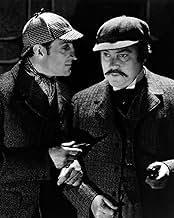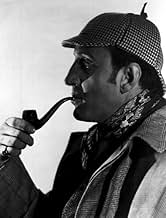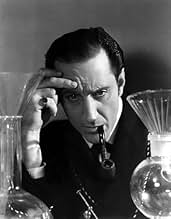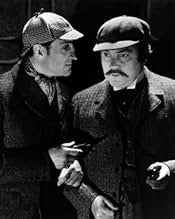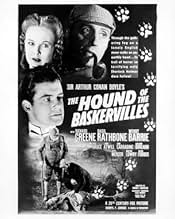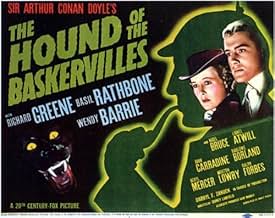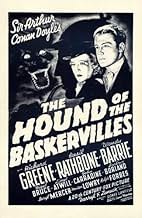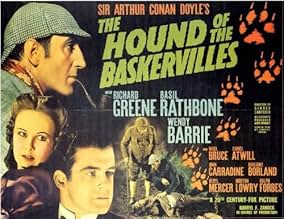NOTE IMDb
7,4/10
12 k
MA NOTE
Sherlock Holmes et le Dr Watson enquêtent sur la légende d'un chien surnaturel. Cette bête traquerait peut-être un jeune héritier sur les landes couvertes de brouillard qui composent son dom... Tout lireSherlock Holmes et le Dr Watson enquêtent sur la légende d'un chien surnaturel. Cette bête traquerait peut-être un jeune héritier sur les landes couvertes de brouillard qui composent son domaine.Sherlock Holmes et le Dr Watson enquêtent sur la légende d'un chien surnaturel. Cette bête traquerait peut-être un jeune héritier sur les landes couvertes de brouillard qui composent son domaine.
- Réalisation
- Scénario
- Casting principal
- Récompenses
- 1 victoire au total
Nigel De Brulier
- Convict
- (as Nigel de Brulier)
Ian Maclaren
- Sir Charles
- (as Ian MacLaren)
Brandon Beach
- Ship Passenger
- (non crédité)
Leonard Carey
- Hugo's Servant
- (non crédité)
Avis à la une
I am a huge fan of all the Rathbone/Bruce movies, but this is the best of them all. The atmosphere and lighting casts the perfect mood for the dark, creepy moor where strange goings on interest Holmes and Watson to help the young heir of Baskerville Hall. All the actors do an excellent job, and the movie, filmed some 60 years go does not seem dated. The writing, directing, acting, etc all stand up, even now, some years later. I also liked the 1959 Hammer Version of this story, but Peter Cushing is not the perfect Sherlock Holmes. Basil Rathbone is the definitive Holmes as Nigel Bruce is the perfect Dr. Watson. Watch this sometime soon and enjoy!!!
"The Hound of the Baskervilles" was the first movie that paired the great actor Basil Rathbone as Sherlock Holmes and Nigel Bruce as his bumbling yet lovable assistant, Dr. Watson. The two actors embody the characters of Holmes and Watson, and it's a delight to see the interaction between the two. This movie is great on all levels, from the creepy atmosphere of the moors where the "hound from hell" roams, to the performances of all the actors involved. Richard Greene, who plays Sir Henry Baskerville, and John Carradine also give solid performances. I remember watching this movie on late night TV with my sister when I was a kid and being genuinely frightened by the scenes on the moor when Richard Greene is being chased by the hound. For me this is the best of the Sherlock Holmes series of movies that was made in the late 1930's and 1940's. A must see!
this is the first filmed version of Sir Arthur Conan Doyle's novel.it's also the first of fourteen Sherlock Holmes films Starring Basil Rathbone as Holmes and Nigel Bruce as his friend/sidekick, Dr. Watson.this is the second version i have seen,the first being the 1959 version starring Peter Cushing and Christopher Lee.i liked that one more.this 1939 version,while good,is slow at times.the acting is good,as one would expect.the story is interesting.as i said,this is a good adaptation,other than the slow pace.otherwise,i was entertained.interestingly,even though they are the main stars,Rathbone is billed second,and Bruce billed fourth in the film.anyway,it's a pretty good 80 minute or so diversion.for me,The Hound of the Baskervilles is an 8/10
Sir Arthur Conan Doyle's best loved Sherlock Holmes work, The Hound of the Baskervilles, gets a beautifully photographed presentation on the screen by director Sidney Lanfield. Basil Rathbone and Nigel Bruce team in their first Holmes film as the world's original reasoning detective Sherlock Holmes and his companion Dr. Watson. Sir Henry Baskerville (Richard Greene) returns from abroad to take up residence in the family estate on the eerie moors in west England. But the foggy landscape appears to be haunted by an invisible creature with demonic powers bent on destroying Sir Henry. Holmes must use all his powers of deduction to solve the case. Although other actors have played Holmes and Watson, Rathbone and Bruce are the undisputed kings. Rathbone brings his rapier profile and fiery intensity to Holmes and Bruce plays Watson like an adoring and faithful puppy dog. They made other adaptations of Holmes together but The Hound of the Baskervilles is the strongest Conan Doyle story and makes for the best movie in the Holmes series.
Of the half dozen or so different takes on The Hound of the Baskervilles that I've seen, this one is my favorite - just barely edging out the Hammer film from 1959. Why? There are a number of reasons I could cite.
1. Acting - The 1939 version of the Hound of the Baskervilles has to have one of the strongest casts ever assembled for a Sherlock Holmes film. It's a veritable Who's Who of 1930s/40s horror/thriller stars. Basil Rathbone, Lionel Atwill, John Carradine, Wendy Barrie, and Eily Malyon all give outstanding performances. Even E.E. Clive appears in a small but enjoyable role. And Nigel Bruce, whose bumbling Watson could really get on my nerves, gives one of his best performances as Holmes' sidekick.
2. Atmosphere - If there's something that filmmakers from the 1930s knew how to do and were especially adept at, its creating atmosphere. From the fog shrouded moors to the dangerous London streets, there's enough atmosphere in The Hound of the Baskervilles for two or three movies. The cinematography and lighting go along way to helping create this feeling. It's something that seems lost on many of today's filmmakers.
3. Direction - While nothing outstanding, Sidney Lanfield is nonetheless solid in the director's chair. One key is the pacing he gives to the film. The movie moves along quite nicely with very few moments that slow things down. Sure, this version of The Hound of the Baskervilles may veer away from the original source material, but it's for good reason. The film would have been too slow and, ultimately, quite dull had it stuck too closely to Sir Arthur Conan Doyle's work. I've read the book, but as much as I enjoy it, I realize changes have to be made for the screen.
While there are a number of other things I could mention in The Hound of the Baskervilles that appeal to me, I'll stop here before this thing gets out of hand. In the end, I've always found this a solid production and a very enjoyable film. I've got no problems rating it a 9/10.
Finally, one thing that has always seemed odd to me is the appeal of The Hound of the Baskervilles. Don't misunderstand, it's a good story. But I'm not sure I understand why it has been filmed more often than any other Sherlock Holmes story. Why would a plot that has its main character (Holmes in this case) disappear for about half the movie be the most famous and most often filmed story from the character's casebook? Like I said, it's just always seemed a bit odd to me.
1. Acting - The 1939 version of the Hound of the Baskervilles has to have one of the strongest casts ever assembled for a Sherlock Holmes film. It's a veritable Who's Who of 1930s/40s horror/thriller stars. Basil Rathbone, Lionel Atwill, John Carradine, Wendy Barrie, and Eily Malyon all give outstanding performances. Even E.E. Clive appears in a small but enjoyable role. And Nigel Bruce, whose bumbling Watson could really get on my nerves, gives one of his best performances as Holmes' sidekick.
2. Atmosphere - If there's something that filmmakers from the 1930s knew how to do and were especially adept at, its creating atmosphere. From the fog shrouded moors to the dangerous London streets, there's enough atmosphere in The Hound of the Baskervilles for two or three movies. The cinematography and lighting go along way to helping create this feeling. It's something that seems lost on many of today's filmmakers.
3. Direction - While nothing outstanding, Sidney Lanfield is nonetheless solid in the director's chair. One key is the pacing he gives to the film. The movie moves along quite nicely with very few moments that slow things down. Sure, this version of The Hound of the Baskervilles may veer away from the original source material, but it's for good reason. The film would have been too slow and, ultimately, quite dull had it stuck too closely to Sir Arthur Conan Doyle's work. I've read the book, but as much as I enjoy it, I realize changes have to be made for the screen.
While there are a number of other things I could mention in The Hound of the Baskervilles that appeal to me, I'll stop here before this thing gets out of hand. In the end, I've always found this a solid production and a very enjoyable film. I've got no problems rating it a 9/10.
Finally, one thing that has always seemed odd to me is the appeal of The Hound of the Baskervilles. Don't misunderstand, it's a good story. But I'm not sure I understand why it has been filmed more often than any other Sherlock Holmes story. Why would a plot that has its main character (Holmes in this case) disappear for about half the movie be the most famous and most often filmed story from the character's casebook? Like I said, it's just always seemed a bit odd to me.
Le saviez-vous
- AnecdotesIn the original novel, and in all later film versions, the butler is named Barrymore. In this version, the butler was renamed Barryman since the famous Barrymore family - Lionel Barrymore, Ethel Barrymore and John Barrymore - were still acting in films at the time.
- GaffesThe Baskerville and Stapleton houses on Dartmoor appear to be lit by gas. At that time, gas was available only in proximity to a gas works and thus only in towns: it was known as "town gas". So people living in remote mansions would have had to rely on candles and oil lamps.
- Citations
[last lines]
Sherlock Holmes: Oh, Watson... the needle.
- ConnexionsEdited into Cynful Movies: The Hound of the Baskervilles (2019)
Meilleurs choix
Connectez-vous pour évaluer et suivre la liste de favoris afin de recevoir des recommandations personnalisées
Détails
- Date de sortie
- Pays d’origine
- Langue
- Aussi connu sous le nom de
- The Hound of the Baskervilles
- Lieux de tournage
- Société de production
- Voir plus de crédits d'entreprise sur IMDbPro
- Durée1 heure 20 minutes
- Couleur
- Rapport de forme
- 1.37 : 1
Contribuer à cette page
Suggérer une modification ou ajouter du contenu manquant

Lacune principale
By what name was Le chien des Baskerville (1939) officially released in Canada in French?
Répondre
